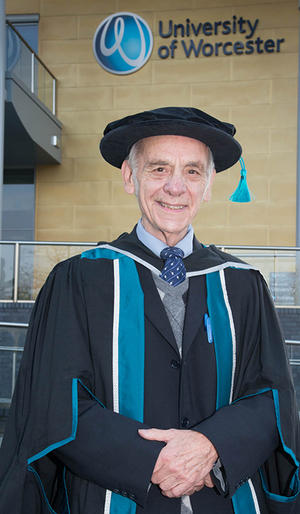Former University of Worcester lecturer, and Fellow, Vic Heyfron, sadly passed away recently. Here we look back on his life.

As a dedicated husband, loving father, master sculptor, teacher, academic, thinker, and even, briefly, as a cabaret star, Victor (Vic) Heyfron always embraced life in all its multi-faceted splendour. From London to Worcester via Blackpool's North Pier, and from the laughter of Eric Morecambe to the philosophy of Arthur Schopenhauer, Vic ceaselessly sought to view the world from every available perspective, a trait that served him well during his 60 year love affair with the art of sculpture.
In his early career, Vic sort fame and fortune on the stage, performing on the flourishing cabaret circuit of the late fifties and early sixties. In later years it was still easy enough to discern the mischievous spark in Vic's character - that easy charm that marks out the born performer.
Vic would often fill time back-stage by producing busts of his fellow performers. From Matt Monro to Eric Morecambe, he sculpted many of the big names of the time.(Below he can be seen with Hank Marvin)
It was during a 1955 stint at the Butlin's holiday camp in Skegness that Vic first met Valerie. A year later they were married."
Theirs was a love that would last a lifetime, and when Vic passed away at home on the 30th of June 2017, after a long and happy marriage, he left Valerie, his two children, Lawrie and Paul, and six grandchildren in the Heyfron family.
Back in the early 1960s, Vic decided to explore his love of art by studying sculpture at St Martin's College. During his time honing his skills at the famous London art school, he worked under such luminaries as Sir Anthony Caro, Dame Elizabeth Frink, and Phillip King.
Although Vic always remembered his time blending sculpture and show business with a great deal of fondness, as the sixties swung on, he decided it was time to leave the stage in search of a more secure future. By the time the decade reached its climax in 1969, Vic was graduating from the University of London as a trained teacher, and securing his first post as Head of Art in a Birmingham secondary school.
Throughout this time, Vic continued to sculpt, although as Valerie remembers, sculpting and family life did not always mix:
"When I was in hospital expecting our first child, Vic used all my saucepans to melt rubber to make moulds for some busts of The Beatles he was working on, "she explains. "He was forever trailing plaster dust through the house."
Fortunately, I'm a very patient person, and we went on to have a long and happy marriage with a wonderful family to share it all with us."
In 1972, Vic took up a position as a lecturer at the then Worcester College of Higher Education. At Worcester vic was able to combine all the great passions of his life: teaching, philosophy, and art.
Vic lectured at what is now the University of Worcester from 1972 to 1990, and in Aesthetics and Art History at the Open University between 1974 and 2008. In 1977 he was awarded a master's in Aesthetics by the University of Birmingham, and in 2014 he was proud to be made a fellow of the University of Worcester.
During his academic career Vic authored several books on the place of art in education, looking at how and why children embrace art in their formative years as a means of making sense of the complexities of the world.
As a professional sculptor, Vic's commissions included a bust of Sir Edward Elgar for the Royal College of Music, busts of the Prince of Wales and Lady Diana for the Royal Borough of Kensington, a bust of the Queen Mother now owned by Her Majesty the Queen, and sculptures of Sir Cliff Richard, Eric Morecambe, and Sir Donald Bradman to name but a few.
Vic remained a passionate advocate for the power of art throughout his life. Talking about his love of sculpture in a 2016 interview, Vic offered insight on both his own artistic process, and the role he saw for art in the world:
"Sculpture is a creative process. You're not just trying to exactly reproduce what you are looking at," he said. "It's more than that, you're interpreting, trying to capture a person's essence as well as their features. It's not just the person but the personae you're looking for.
"Art is its own reward," he added, "and like children trying to develop their understanding through storytelling, only through art can we come to terms with the enormity and complexity of our world."